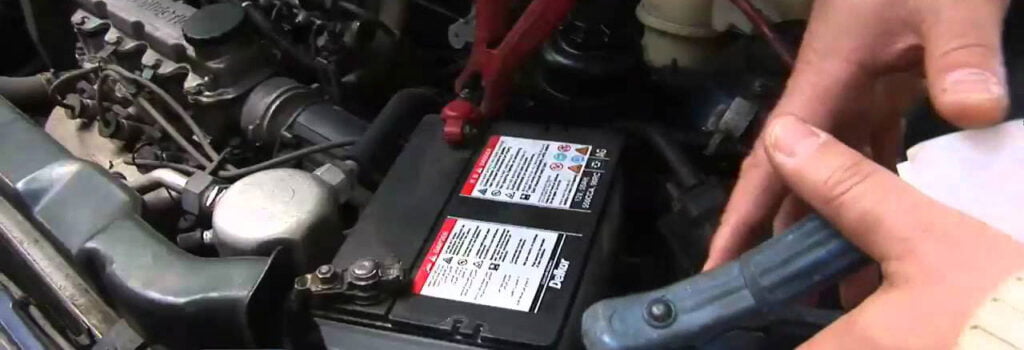Ever felt stranded by a car that just won’t start? Spotting the warning signs of a dying battery matters more than ever because modern vehicles rely on more electronics, from power windows to engine computers. Catching symptoms early can save you from a breakdown and help avoid expensive repairs down the road. Knowing what to look for, and what to do next, makes it easier to keep your ride running smoothly and your schedule on track.
Key Signs Your Car Battery Might Be Failing
When your car’s battery is on its way out, it rarely gives up all at once. Most of the time, it sends out warning signals, both subtle and obvious, that something isn’t right. Paying attention to these details—how your car feels, sounds, and even how it smells—can make all the difference between a quick fix and hours stranded in a parking lot. Let’s look at the most common clues your battery is getting weak.
Slow Engine Crank or Struggling Start
You may notice your car’s engine cranking slower than usual when you turn the key. Instead of a quick start, it hesitates, almost like it’s catching its breath. This sluggish response means the battery doesn’t have enough power to spin the engine as fast as it should. Sometimes, the car might even fail to start completely, forcing you to try again or reach for the jumper cables.
A healthy battery gives a strong, confident start. If you hear that lazy, drawn-out rurr-rurr-rurr sound more than once, it’s time to pay attention.
Dim or Flickering Headlights and Electrical Issues
If your headlights are losing their brightness or flicker when idling, your battery could be losing its charge. This isn’t just about headlights—other electrical features like dashboard lights, window controls, or the radio might start to act up too. Weak or intermittent power is a big clue your battery’s voltage is dropping.
Modern cars depend on the battery to keep all electronics running smoothly. Electrical hiccups often mean the battery can’t keep up.
Clicking Sounds or Multiple Jump-Start Requests
 Photo by Daniel @ bestjumpstarterreview.com
Photo by Daniel @ bestjumpstarterreview.com
When you turn the ignition and all you get is a rapid clicking sound, the battery almost always gets the blame. This clicking happens when there’s just not enough juice for the starter motor. It’s one of the most common ways a battery says it’s about to tap out.
If your car starts needing frequent jump-starts, especially after sitting for just a few hours, it’s likely more than just a one-off problem. Most batteries shouldn’t need outside help more than once or twice in their life.
Warning Lights on the Dashboard
That little battery-shaped warning light isn’t just decoration. If it comes on—especially while driving—it signals a problem with your battery or the charging system. Sometimes, the “Check Engine” or other warning lights can also appear if the battery’s voltage is too low.
Don’t ignore dash lights. They’re the car’s way of telling you to check under the hood.
Corrosion, Swelling, and Odd Smells from the Battery
Pop the hood and look at your battery. If you spot white, blue, or green powder around the terminals (the cable connections), that’s corrosion caused by acid leakage. This can mess with electrical flow and speed up battery failure.
Other visible signs include:
- Swelling or a warped battery case (could look bloated or misshapen)
- Cracked or leaking areas
- Dampness or evidence of dried battery acid nearby
If there’s a nasty rotten-egg or sulfur-like smell coming from the battery, it often means it’s venting dangerous hydrogen sulfide gas—a sign of chemical breakdown. These symptoms mean the battery isn’t just weak, it could be unsafe.
Keeping an eye on these warning signs helps you stop a minor issue from turning into a major problem on the road.
Visual and Electrical Tests to Diagnose Battery Health
When you suspect your battery is on its way out, don’t just guess. A good inspection and a few quick tests can give you clear answers—right in your driveway. Here’s how you can spot problems fast, whether you’re eyeballing the battery yourself, using a multimeter, or checking your dashboard with modern technology.
Inspecting for Corrosion and Physical Damage
Pop the hood and start with a close look at the battery. It’s surprising how much you can learn just by using your senses:
- Corrosion: Check for powdery white, blue, or green buildup on the terminals. Corrosion blocks electricity, making starting your car harder. Removing the corrosion with a battery cleaning brush and a mix of baking soda and water can help, but heavy buildup may mean acid leakage and deeper problems.
- Swelling: If the battery case looks bloated or misshapen, internal pressure is building up—a classic sign it’s failing.
- Leaking or Cracks: Moisture, dried acid, or visible cracks mean the battery should be changed as soon as possible.
- Smells: A sharp, rotten egg odor is a warning that the battery is venting dangerous gases from chemical breakdown. Don’t ignore this.
Simple as this check is, it often tells you if the battery is unsafe or getting close to its last days.
 Photo by Themba Mtegha
Photo by Themba Mtegha
Checking Voltage with a Multimeter
Testing voltage at home is a straightforward way to see how your battery is holding up. Here’s how you do it:
- Turn off your car. Wait at least 10-15 minutes so the battery isn’t still charged from recent running. This gives a true reading.
- Set your multimeter to DC volts. Connect the red probe to the positive terminal and the black probe to the negative.
- Read the voltage:
- Healthy battery: 12.6–12.7 volts
- Getting weak: 12.4 volts or below
- Needs a jump or replacement: Below 12.0 volts
You can test deeper by watching the voltage drop when you crank the engine:
- If it drops under 10.5 volts, the battery is struggling under load—likely on its last legs.
Keep in mind, simple voltage tests are a great first step. If you want a pro-level check, some auto parts stores will do a conductance or load test for free.
Reading Battery Health from On-Board Diagnostics
Modern cars and trucks often tell their own story about battery health, thanks to built-in diagnostics and smart sensors.
- Dashboard Displays: Some newer vehicles show battery voltage or health warnings right on the display screen. Don’t ignore sudden drops or alerts.
- OBD-II Scanners: These handy devices plug into a port under your dash. With basic models, you can:
- Read live battery voltage
- Check for stored error codes about charging problems
- Spot issues before they leave you stranded
New diagnostic systems go much further by:
- Tracking the battery’s internal resistance and charge cycles
- Alerting you to changes in performance or early signs of failure
- Using advanced algorithms to predict when your battery will need replacement
This technology is now common even in popular gas-powered vehicles, not just electric cars. If your check engine light is on, a quick OBD-II scan can tell you if a weak battery is to blame—or if something more serious is brewing.
Simple DIY tests combined with today’s smart tech tools mean you don’t have to guess about your car battery’s health. Catch issues early and you’ll save time, money, and headaches down the road.
Common Causes and Risk Factors for Battery Failure
Before your car battery gives up for good, there’s a high chance it’s been put through stress it wasn’t built to handle. From natural aging to rough weather and overlooked maintenance, a lot can go wrong under the hood. Here’s why batteries rarely make it to “old age” without issues—and what actually shortens their life.
Age and Typical Lifespan of Car Batteries
Most car batteries aren’t designed to last forever. The average car battery gives strong, reliable starts for about 3 to 5 years. Some high-end AGM or EFB batteries will stretch to 6 or 7 years, but that’s more the exception. How long yours lasts depends on:
- Climate: Hot summers and freezing winters both speed up battery aging.
- Driving habits: Short trips or infrequent use don’t let the battery fully recharge.
- Type and quality: Cheaper batteries wear out faster. High-quality brands and the right group size fit go further.
- Car usage: More electronics mean more drain.
Most batteries lose capacity slowly. Warning signs start to show up after the three-year mark, making yearly checks a smart move. Waiting for a total failure is asking for trouble—many roadside service calls are caused by batteries that hit their expiration date without warning.
Impact of Extreme Temperatures
 Photo by Max
Photo by Max
Weather can be both your battery’s best friend and worst enemy. High heat and deep freezes each take a heavy toll but in very different ways:
- Heat: Summer’s high temps evaporate the battery’s internal fluids. Heat also accelerates the chemical reactions inside, making the battery work harder and corrode faster from the inside out. It’s why batteries in Phoenix or Miami rarely see year five.
- Cold: Freezing temps won’t kill a healthy battery right away, but they do slow the chemical process needed to start your engine. If your battery is already weak, the cold will finish it off. The thicker the oil in your engine, the more energy your battery has to deliver—and a tired battery just can’t keep up.
No region is immune. Hot climates drain batteries quickly, while cold weather will expose any weakness when you least expect it.
Electrical Drains and Improper Maintenance
Electrical drains don’t just happen when you leave the headlights on overnight. Modern cars have tiny power draws—even while parked—thanks to clocks, alarms, and sensors. These small but steady “parasitic” drains can flatten a weak battery in a few days.
Batteries also take a hit from:
- Corroded terminals: Dirt and corrosion block power flow, making your battery work harder just to do basic tasks.
- Loose or damaged cables: Poor connections mean energy loss—and sometimes, the car won’t start at all.
- Frequent short trips: The alternator doesn’t get enough time to recharge the battery. Over time, the battery never catches up.
- Failure to clean: Letting grime or moisture sit on top of the battery can speed up corrosion and promote electrical leaks.
- Deep discharges: Repeatedly running the battery until it’s dead (like with a forgotten light or a faulty switch) weakens its ability to hold a charge after each cycle.
Regular check-ups, keeping terminals clean, and driving your car long enough to recharge the battery are simple ways to avoid most electrical drain risks. Ignoring these basics is one of the fastest paths to battery trouble.
What To Do If You Suspect Your Battery Is Failing
You’ve spotted the warning signs—a hard start, flickering lights, maybe even a faint rotten-egg smell. Acting quickly can save you time, money, and the headache of getting stranded. Use these steps to stay safe, get your battery checked, and make a smart replacement choice, so you don’t end up stuck on the side of the road.
Prioritize Safety and Prevent Further Damage
If you think your battery is failing, start by putting safety first. A weak or damaged battery can leak acid, vent toxic gases, or even short circuit under the hood. Here’s what to keep in mind:
- Turn everything off: Shut down all accessories—radio, lights, A/C—before attempting a restart. This reduces the strain on your failing battery and prevents electrical surges.
- Avoid repeated cranking: Pressing the start button or turning the key multiple times in a row can overheat battery terminals and stress the starter motor.
- Check for leaks or swelling: If you see bulges or signs of acid leakage, do not touch the battery. Corrosive leaks and off-gassing are dangerous. If there’s a strong sulfur smell, keep your distance and have a pro inspect it.
- Park in a safe area: Move the car from traffic or a hazardous spot if possible, using a jump-start only if you’re in a secure place.
If you’re unsure or see warning signs of damage, call a roadside service or local shop rather than risking injury or further electrical issues.
Seek Professional Testing or Visit an Auto Shop
Don’t leave your next moves up to guesswork. Even the best DIY checks can miss problems that only show up under load or as part of a bigger electrical issue.
- Many national auto parts chains offer free battery testing while you wait. These tests measure battery voltage and performance under simulated starting conditions.
- Professional shops use conductance or load testers, which reveal remaining battery life and flag unseen problems with your charging system (like alternator failure).
- If the battery passes but you still have starting issues, a shop can check for issues with cables, connections, or the starter itself.
If your battery is more than three years old, even if it “tests fine,” consider a preemptive replacement to avoid unexpected trouble, especially before a road trip or at the start of a new season.
 Photo by Daniel @ bestjumpstarterreview.com
Photo by Daniel @ bestjumpstarterreview.com
How to Choose a Replacement Battery
Buying a replacement battery isn’t just about picking what’s on sale. A smart match keeps your car running strong and protects your investment. Key things to check:
- Battery size and fit: Check your owner’s manual for the group size. An ill-fitting battery can lead to loose connections and vibration damage.
- Cold Cranking Amps (CCA): Make sure the rating meets or exceeds your car manufacturer’s requirements, especially if you live in a cold climate.
- Reserve capacity: Higher reserve means your battery will power accessories longer if your alternator fails.
- Warranty: A longer free-replacement warranty is always a plus. It’s a sign of confidence in the battery’s quality.
- Type: Modern cars often use AGM (absorbed glass mat) batteries, which hold up better to stop-start driving and heavy electronics. Older cars usually use lead-acid batteries—double-check what yours needs.
Don’t forget to check the manufacturing date on the label and buy the freshest battery you can. Batteries lose strength sitting on store shelves.
Basic Tips to Avoid Future Battery Failure
Now’s the perfect time to build better battery habits so you won’t face the same hassle again. Keep your next battery healthy by following these simple steps:
- Tighten and clean battery terminals during oil changes to prevent corrosion and weak connections.
- Limit accessories when the engine is off—especially phone chargers, dash cams, and lights.
- Take longer drives to let the alternator recharge the battery fully; frequent short trips drain healthy batteries fast.
- Check voltage a couple of times a year with a basic digital multimeter—less than 12.4 volts is a warning sign.
- Test or replace before trips—bring the car in for a free check if it’s been two or more years since the last battery change.
Protect your investment by keeping the battery secure in its tray and having old batteries recycled properly at an auto parts store. These small steps keep your car starting strong rain or shine.
Conclusion
Catching battery problems early keeps you in control, not stuck waiting for a tow. A quick check or voltage test can spot trouble before it ruins your day. Replacing a weak battery on your own terms is cheaper and far less stressful than handling an emergency breakdown.
Regular attention pays off—just like oil changes and tire checks, making battery care part of your routine adds peace of mind. Don’t let small warning signs become big disruptions.
Thanks for reading—share your own experiences or tips below, and follow for more simple car care guides that keep you moving.




